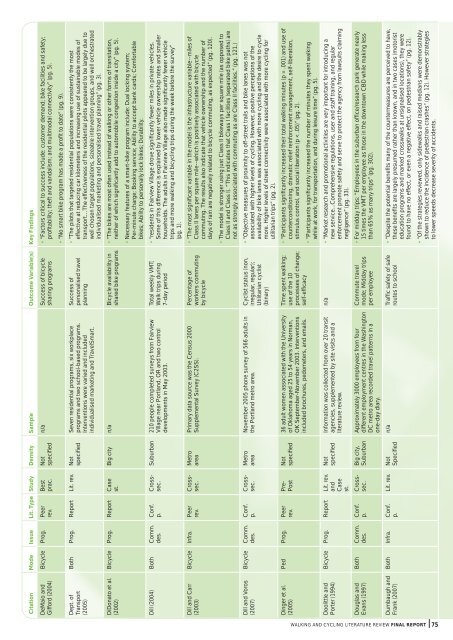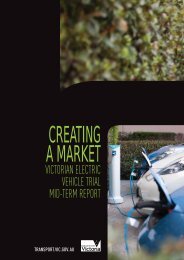Walking and Cycling International Literature Review - Department of ...
Walking and Cycling International Literature Review - Department of ...
Walking and Cycling International Literature Review - Department of ...
You also want an ePaper? Increase the reach of your titles
YUMPU automatically turns print PDFs into web optimized ePapers that Google loves.
Citation Mode Issue Lit. Type Study Density Sample Outcome Variable(s) Key Findings<br />
DeMaio <strong>and</strong><br />
Gifford (2004)<br />
Bicycle Prog. Peer<br />
rev.<br />
Best<br />
prac.<br />
Not<br />
specified<br />
n/a Success <strong>of</strong> bicycle<br />
sharing programs<br />
• “Factors critical to success include: customer dem<strong>and</strong>; bike facilities <strong>and</strong> safety;<br />
pr<strong>of</strong>itability; theft <strong>and</strong> v<strong>and</strong>alism; <strong>and</strong> multimodal connectivity” (pg. 5).<br />
• “No smart bike program has made a pr<strong>of</strong>it to date” (pg. 9).<br />
Dept. <strong>of</strong><br />
Transport<br />
(2005)<br />
Both Prog. Report Lit. rev. Not<br />
specified<br />
Seven residential programs, six workplace<br />
programs <strong>and</strong> two school-based programs.<br />
Interventions were varied <strong>and</strong> included<br />
individualised marketing <strong>and</strong> TravelSmart.<br />
Success <strong>of</strong><br />
personalised travel<br />
planning<br />
• “The pilots that targeted residential populations were consistently the most<br />
effective at reducing car kilometers <strong>and</strong> increasing use <strong>of</strong> sustainable modes <strong>of</strong><br />
transport…The effectiveness <strong>of</strong> the residential pilots appeared to be largely due to<br />
well chosen target populations, sizeable intervention groups, <strong>and</strong> well orchestrated<br />
individualised marketing <strong>and</strong> personalised travel planning” (pg. 3).<br />
DiDonato et al.<br />
(2002)<br />
Bicycle Prog. Report Case<br />
st.<br />
Big city n/a Bicycle availability in<br />
shared bike programs<br />
• “The bikes are most <strong>of</strong>ten used instead <strong>of</strong> walking or other forms <strong>of</strong> transitation,<br />
neither <strong>of</strong> which significantly add to automobile congestion inside a city” (pg. 5).<br />
• Necessary features <strong>of</strong> a smart-bike program include: Dual locking system;<br />
Per-minute charge; Booking service; Ability to accept bank cards; Comfortable<br />
bikes; Ability to personally lock bikes; Durability.<br />
Dill (2004) Both Comm.<br />
des.<br />
Conf.<br />
p.<br />
Suburban 210 people completed surveys from Fairview<br />
Village near Portl<strong>and</strong>, OR <strong>and</strong> two control<br />
developments in May 2003.<br />
Total weekly VMT;<br />
Walk trips during<br />
7-day period<br />
• “residents in Fairview Village drove significantly fewer miles in private vehicles.<br />
Some <strong>of</strong> this difference is explained by lower vehicle ownership rates <strong>and</strong> smaller<br />
households. The adults in Fairview Village also made significantly fewer vehicle<br />
trips <strong>and</strong> more walking <strong>and</strong> bicycling trips during the week before the survey”<br />
(pg. 1).<br />
Dill <strong>and</strong> Carr<br />
(2003)<br />
Bicycle Infra. Peer<br />
rev.<br />
Metro<br />
area<br />
Primary data source was the Census 2000<br />
Supplemental Survey (C2SS).<br />
Percentage <strong>of</strong><br />
workers commuting<br />
by bicycle<br />
• “The most significant variable in the model is the infrastructure variable--miles <strong>of</strong><br />
Class II lanes per square mile--which is positively associated with bicycle<br />
commuting. The results also indicate that vehicle ownership <strong>and</strong> the number <strong>of</strong><br />
days <strong>of</strong> rain are negatively related to bicycle commuting, as expected” (pg. 120).<br />
• The model is stronger using just Class II bikeways per square mile (as opposed to<br />
Class II <strong>and</strong> Class I). “This indicates that Class I facilities (separated bike paths) are<br />
not as strongly associated with commuting as are Class II facilities.” (pg. 121.)<br />
Dill <strong>and</strong> Voros<br />
(2007)<br />
Bicycle Comm.<br />
des.<br />
Conf.<br />
p.<br />
Metro<br />
area<br />
November 2005 phone survey <strong>of</strong> 566 adults in<br />
the Portl<strong>and</strong> metro area.<br />
Cyclist status (non,<br />
irregular, regular);<br />
Utilitarian cyclist<br />
(binary)<br />
• “Objective measures <strong>of</strong> proximity to <strong>of</strong>f-street trails <strong>and</strong> bike lanes was not<br />
associated with higher levels <strong>of</strong> cycling. However, positive perceptions <strong>of</strong> the<br />
availability <strong>of</strong> bike lanes was associated with more cycling <strong>and</strong> the desire to cycle<br />
more. Higher levels <strong>of</strong> street connectivity were associated with more cycling for<br />
utilitarian trips” (pg. 2).<br />
Dinger et al.<br />
(2005)<br />
Ped Prog. Peer<br />
rev.<br />
Crosssec.<br />
Crosssec.<br />
Crosssec.<br />
Pre-<br />
Post<br />
Not<br />
specified<br />
36 adult women associated with the University<br />
<strong>of</strong> Oklahoma aged 25 to 54 years in Norman,<br />
OK September-November 2003. Interventions<br />
included brochures, pedometers, <strong>and</strong> emails.<br />
Time spent walking;<br />
use <strong>of</strong> the 10<br />
processes <strong>of</strong> change;<br />
self-efficacy<br />
• “Participants significantly increased their total walking minutes (p = .001) <strong>and</strong> use <strong>of</strong><br />
counterconditioning, dramatic relief reinforcement management, self-liberation,<br />
stimulus control, <strong>and</strong> social liberation (p < .05)” (pg. 2).<br />
• “Participants significantly increased the number <strong>of</strong> minutes they spent walking<br />
while at work, for transportation, <strong>and</strong> during leisure time” (pg. 5).<br />
Doolittle <strong>and</strong><br />
Porter (1994)<br />
Bicycle Prog. Report Lit. rev.<br />
<strong>and</strong><br />
Case<br />
st.<br />
Not<br />
specified<br />
Information was collected from over 20 transit<br />
agencies, supplemented by site visits <strong>and</strong> a<br />
literature review.<br />
n/a • “Market research <strong>and</strong> promotional activities are very important for introducing a<br />
new service...Comprehensive regulations, user <strong>and</strong> staff training, <strong>and</strong> regular<br />
enforcement promote safety <strong>and</strong> serve to protect the agency from lawsuits claiming<br />
negligence” (pg. 33).<br />
Douglas <strong>and</strong><br />
Evans (1997)<br />
Both Comm.<br />
des.<br />
Conf.<br />
p.<br />
Crosssec.<br />
Big city,<br />
Suburban<br />
Approximately 3000 employees from four<br />
different employment centres in the Washington<br />
DC metro area recorded travel patterns in a<br />
one-day diary.<br />
Commute travel<br />
mode; Midday trips<br />
per employee<br />
• For midday trips: “Employees in the suburban <strong>of</strong>fice/research park generate nearly<br />
15 times the VMT per employee as those in the downtown CBD while making less<br />
than 65% as many trips” (pg. 302).<br />
Dumbaugh <strong>and</strong><br />
Frank (2007)<br />
Both Infra. Conf.<br />
p.<br />
Lit. rev. Not<br />
Specified<br />
n/a Traffic safety <strong>of</strong> safe<br />
routes to school<br />
• “Despite the potential benefits many <strong>of</strong> the countermeasures are perceived to have,<br />
these benefits are largely presumed rather than known, <strong>and</strong> in two cases (motorist<br />
education programs <strong>and</strong> marked crosswalks at unsignalised locations), they were<br />
found to have no effect, or even a negative effect, on pedestrian safety” (pg. 12).<br />
• “Of the strategies reviewed, only sidewalks <strong>and</strong> raised medians were demonstrably<br />
shown to reduce the incidence <strong>of</strong> pedestrian crashes” (pg. 12). However strategies<br />
to lower speeds decrease severity <strong>of</strong> accidents.<br />
WALKING AND CYCLING LITERATURE REVIEW FINAL REPORT 75

















